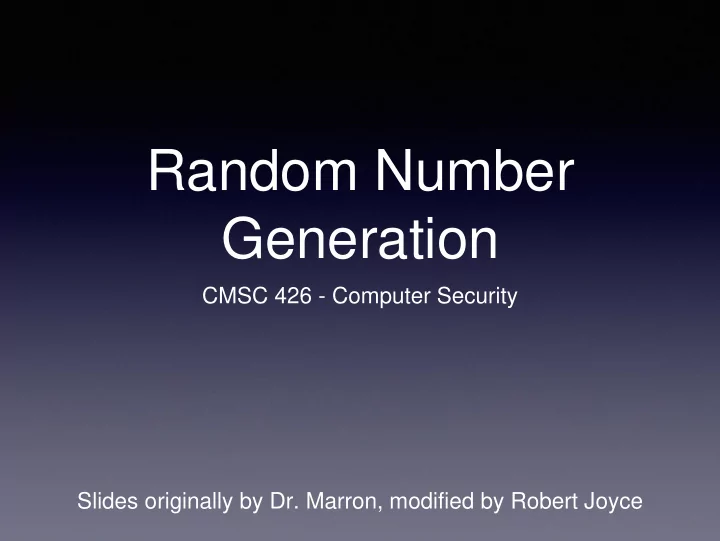

Random Number Generation CMSC 426 - Computer Security Slides originally by Dr. Marron, modified by Robert Joyce
Outline • Properties of PRNGs • LCGs • Blum, Blum, Shub • NIST SP 800-90A
Random Number Uses • Generation of symmetric keys • Generation of primes ( p and q ) for RSA • Generation of secret keys for Diffie-Hellman • Nonces for cryptographic protocols
The “P” in “PRNG” • Don’t typically have access to a true random number generator (RNG). • RNGs require some source of random noise, i.e. special hardware. • Instead, use an algorithm that produces numbers that appear random - a Pseudo-Random Number Generator or PRNG . • NIST documents also refer to a PRNG as a Deterministic Random Bit Generator (DRBG).
PRNG Requirements • Statistical Properties. What does it mean to “appear random?” • Output of the PRNG should be uniformly distributed . • Outputs should appear independent . Can not infer a value from a previous or future value. • Unpredictability . For cryptography, the statistics don’t matter so much as that the values be unpredictable.
A simple PRNG • The Linear Congruential Generator (LCG) is perhaps the most commonly used PRNG. • Given constants a , c , and m and an initial seed X 0 , generate numbers according to the formula X n +1 = ( a X n + c ) mod m • The selection of the constants is important.
LCG Examples • Example: a = c = 1. • Example: a = 7, c = 0, m = 32, X 0 = 1. • Example: a = 5, c = 0, m = 32, X 0 = 1.
Good LCGs? • What would make an LCG good? 1. Full-period generating — generates all values 0 < X < m . 2. Should appear random as determined by a battery of statistical tests. 3. Efficient on current architectures (64 bit).
LCG Parameters • If n is a power of two, choose a , c such that 1. c is relatively prime to n (so c is odd). 2. a - 1 is divisible by 4. Hull & Dobell, Random Number Generators , SIAM Review, Vol. 4, No. 3 (July 1962), pp. 230 - 254. • Some examples from Wikipedia: n a c 2 31 glibc 1103515245 12345 2 32 MS Quick C 214013 2531011
LCGs are Weak • Unfortunately, LCGs are not appropriate for cryptography. • Python uses a PRNG called a Mersenne Twister , which is better than an LCG, but still not good enough for cryptography.
Blum, Blum, Shub • We’ve seen that a simple PRNG isn’t suitable for cryptography (LCG) • The Blum, Blum, Shub (BBS) generator is simple and secure — but has its own limitations. • BBS is provably secure if used correctly; its security is based on the difficulty of factoring.
BBS Parameters • Construct a composite modulus M = p ⋅ q with the following properties: • p and q are primes of “cryptographic size” (at least 512 bits each) • p and q are both congruent to 3 mod 4. • Generate a seed x 0 , a random positive integer less than M and relatively prime to M .
BBS Generation • The state of the generator is updated according to the rule: x i+1 = x i2 mod M . • From each x i , extract the low-order bit. That is, the pseudo-random sequence is: b i = x i mod 2, i = 1, 2, 3, … • Example: p = 7, q = 11, x 0 = 17.
Security and Efficiency • Given a sequence of b i values, it is “difficult” to recover a state x j (future or past). • The difficulty is proven to be equivalent to a hard mathematical problem, which is in turn is believed to be equivalent to factoring M . • So what is the downside? Efficiency. We are computing one modular exponentiation for each bit of pseudo-random output.
NIST SP 800-90A • PRNG based on AES in CTR mode which is suitable for cryptographic applications . • Note: NIST uses the term Deterministic Random Bit Generator (DRBG) rather than PRNG. • The algorithm consists of separate Initialization and Generation phases. • We’ll see a simplified version of the standard using AES- 128…
Initialization • The following steps initialize the PRNG: 1. Obtain 256 bits of random "seed" data; the first 128 bits will be denoted ( K 0 ), and the remaining 128 bits will be denoted ( V 0 ). 2. Initialize V and K to zero. 3. Update V ← V + 1 mod 2 128 . 4. Encrypt V with key K ; save the output K' . 5. Update V ← V + 1 mod 2 128 . 6. Encrypt V with key K ; save the output V' . 7. Set K = K 0 ⊕ K' and V = V 0 ⊕ V' .
Generation • Generation of n blocks of pseudo-random data: 1. Update V ← V + 1 mod 2 128. Encrypt V with key K ; save output as X . 2. Update Output ← Concatenate(Output, X) . 3. Repeat steps 1 - 3 a total of n times. 4. Return Output . • After generation, V and K are updated using steps 3 - 7 of the Initialization. • A counter tracks the total number of pseudo-random bits produced; after some threshold, the PRNG must be re- initialized.
Which PRNG to use? • For non-cryptographic applications an LCG is usually sufficient. • For small volumes of critical pseudo-random bits , BBS would be a reasonable choice, but there are few other practical uses • For large volumes of pseudo-random bits , a PRNG from SP 800-90A will be secure and efficient. There are many other PRNGS: this is just a sample!
Recommend
More recommend